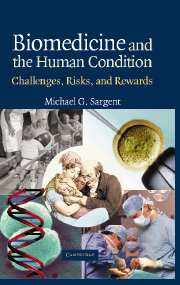Book contents
- Frontmatter
- Contents
- Preface
- 1 Challenges, Risks, and Rewards: Learning to Control Our Biological Fate
- 2 Learning to Breed Successfully
- 3 How Life is Handed On
- 4 Cells in Sickness and Health
- 5 Experiences in Utero Affect Later Life
- 6 Infection, Nutrition, and Poisons: Avoiding an Unhealthy Life
- 7 Signs of Ageing: When Renovation Slows
- 8 Cancer and the Body Plan: A Darwinian Struggle
- 9 Fighting Infection
- 10 Are Devastating Epidemics Still Possible?
- 11 Discovering Medicines: Infinite Variety through Chemistry
- 12 Protein Medicines from Gene Technology
- 13 Refurbishing the Body
- 14 Living with the Genetic Legacy
- 15 Epilogue: Signposts to “Wonderland”
- References
- Index
10 - Are Devastating Epidemics Still Possible?
Published online by Cambridge University Press: 06 August 2009
- Frontmatter
- Contents
- Preface
- 1 Challenges, Risks, and Rewards: Learning to Control Our Biological Fate
- 2 Learning to Breed Successfully
- 3 How Life is Handed On
- 4 Cells in Sickness and Health
- 5 Experiences in Utero Affect Later Life
- 6 Infection, Nutrition, and Poisons: Avoiding an Unhealthy Life
- 7 Signs of Ageing: When Renovation Slows
- 8 Cancer and the Body Plan: A Darwinian Struggle
- 9 Fighting Infection
- 10 Are Devastating Epidemics Still Possible?
- 11 Discovering Medicines: Infinite Variety through Chemistry
- 12 Protein Medicines from Gene Technology
- 13 Refurbishing the Body
- 14 Living with the Genetic Legacy
- 15 Epilogue: Signposts to “Wonderland”
- References
- Index
Summary
Great epidemics of the past occurred following a collision between a rampant microbe and a totally defenceless population living in circumstances in which the disease could spread freely. The enormous menace of HIV and the prion diseases originate in the novelty of their disease-causing capability and their ability to exploit weaknesses in our hygienic arrangements. Other formerly dangerous diseases still have an undiminished ability to kill humans on a large scale. Malaria – less menacing outside of Africa than in former times – remains one of the world's greatest health problems. Tuberculosis is, in principle, curable, but the difficulty of implementing effective treatment means that it persists. Indeed, it infects one-third of the world's population, and in HIV infected people it is now creating a severe danger. The influenza virus has a history of creating unpleasant surprises, but it is now under control because of a remarkable surveillance and vaccination program. Bioterrorism makes health officials nervous. Complacent in our belief that smallpox has been eradicated, and with our immunity to smallpox steadily diminishing, we could be vulnerable to bioterrorists. The important lesson of the last thirty years is that we should never assume that microbial enemies are vanquished and should recognise that microbes exploit chinks in our hygienic armour.
Should We Worry about Unknown Infectious Enemies?
Industrial countries with well-developed sanitation and public health systems are no longer at risk from the old villains such as plague, cholera, and typhus, but new infectious diseases can still surprise us.
- Type
- Chapter
- Information
- Biomedicine and the Human ConditionChallenges, Risks, and Rewards, pp. 199 - 219Publisher: Cambridge University PressPrint publication year: 2005



